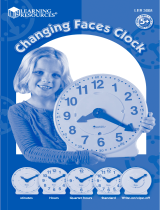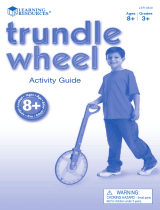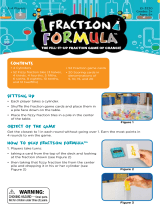Page is loading ...

LER 2995
24 Hour Learning Clock
®
Horloge d’apprentissage 24 heures • 24-Stunden-Lernuhr
Reloj de aprendizaje de 24 horas • 24-timmars klocka för undervisning
R
E
C
O
M
M
E
N
D
E
D
F
O
R
•
A
G
E
S
4
A
N
D
U
P
•
ACTIVITY GUIDE • GUIDE D’ACTIVITÉS • SPIELANLEITUNG
GUÍA DE ACTIVIDADES • AKTIVITETSHANDLEDNING
For a dealer near you, call:
(847) 573-8400 (U.S. & Int’l)
(800) 222-3909 (U.S. & Canada)
+44 (0)1553 762276 (U.K. & Europe)
© Learning Resources, Inc., Vernon Hills, IL (U.S.A.)
Learning Resources Ltd., King’s Lynn, Norfolk (U.K.)
Please retain our address for future reference.
Made in China. LRM2995-GUD
U.S. Patent No. D377, 949 • U.K. Design 2054671
U.S. Patent No. 5,851,118
N
E
W
&
I
M
P
R
O
V
E
D
TM
2995 GUD 3/19/07 9:43 AM Page 1

Activity Guide
The Primary Time Teacher™ (LER2995), with its new and improved design,
will help your students make connections between analog and digital time-
telling formats. The Primary Time Teacher™ is unique in that it has both an
analog clock and a digital clock that work simultaneously. Turn the knob on
the minute hand and watch both the synchronized hour hand and the
digital numbers turn. The hours and the minutes on both the analog and
the digital clocks are color coordinated so your students can make
transitions between the clocks with ease.
The Primary Time Teacher™ can be used in a variety of learning
environments. Place the clock in a learning center for students to explore
or to use in directed activities. Your students will love to turn the hands,
watch the mechanisms move, and learn to tell time making connections
between analog and digital clocks.
Connections
Point out the hour hand on the analog clock. Ask the students to describe
its features. Students might notice that the hour hand is short and that it is
red. Then, ask students to guess which numbers on the digital clock are the
hours. The hours are printed in red. Point out the minute hand and ask
students to describe its features. Make connections between the color of
the minute hand and the printed minutes on the digital clock.
Slowly turn the minute hand. Encourage students to describe what
happens. Students should notice that the minutes change frequently on the
digital clock, but the hours only change when a complete revolution has
been made. Explore the relationship between how often the digital clock’s
numbers change and the distance the minute hand travels.
Minutes
The Primary Time Teacher™ helps students find the number of minutes in
an hour. Ask students if they know how many minutes are in an hour.
Then, ask students how they can find out.
Discuss their suggestions and try them. The minute hand points to the tick
marks around the edge of the analog clock. Ask students what they think
these tick marks represent. (The space between each tick mark shows one
minute.)
Count the tick marks on the clock. There are sixty minutes in an hour. As
soon as sixty is reached, the minutes start all over again. Each time you
move the minute hand, the minute numbers on the digital clock turn.
Hours
The Primary Time Teacher™ tracks both analog and digital time through a
24-hour day. Ask students how many hours are shown on the clock. Ask
them what they think happens when the clock goes from 24:00 to 1:00.
5-Minute Time
Help your students tell time in five-minute intervals. Close the digital
windows. Show a time on your analog face. Ask students to tell how many
minutes and hours are shown. Then, open the digital windows so students
can check their times. Reverse the process. Show students a time on the
digital face, then ask them to tell where the hour and minute hand should
be.
Time Clocks
Time for play! The Primary Time Teacher™ is similar to a clock used often in
work places everywhere. Encourage students to pretend they are going to
work. They should tell the time they will arrive and show it on the clock.
You can even make time cards for students to practice writing times in
digital formats or in words. For example, students could write 15:00.
Encourage students to punch in and out of class each day to practice
modeling and telling times.
Elapsed Time
Use the Primary Time Teacher™ to practice elapsed time. Students should
write down the time the "punch in" and the time they "punch out." Then,
they can use the clock to find the elapsed time. Students can turn the
crank and count the hours and minutes elapsed. Students could tell how
long they were in a class, how long they spent on a particular task, or how
long the were "at work."
Tell Me When
Reinforce students’ time-telling skills and their understanding of time
duration by asking them to "tell me when." Encourage students to tell you
when it is time for lunch, break, or a specific activity. Try to set these
activities for certain times throughout the day.
2995 GUD 3/19/07 9:43 AM Page 3
/










